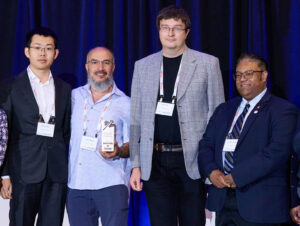
CivMin researchers, Professor Baher Abdulhai and Dr. Xiaoyu Wang (CivMin PhD 2T3), and Dr. Ilia Smirnov from the City of Toronto (a former U of T Research Associate) have won a research and development (R&D) award for their work self-learning traffic lights using Artificial Intelligence (AI) to reduce traffic congestion, in close collaboration with the City of Toronto Traffic Management Department directed by CivMin alumnus Mr. Roger Browne (CivE 9T9).
The Intelligent Transportation Society of Canada (ITS Canada) presented them as the 2025 Excellence in R&D Award recipient for the eMARLIN-Transformer: State of the Art AI-Based Urban Traffic Control. ITS Canada recently celebrated winners of the ITS Canada Awards: Member of the Year Awards, Intelligent Mobility Awards, Excellence in R&D Awards, Young Innovators and Leaders in Transportation Award. Nine winners, in four different categories, garnered recognition from ITS Canada.
The citation from ITS Canada:
The 2025 Excellence in R&D Award recipient is eMARLIN-Transformer: State of the Art AI-Based Urban Traffic Control .
Part of the solution to urban congestion challenges in harnessing the power of Artificial Intelligence (AI), Reinforcement Learning (RL) and, most recently, Transformers for real time traffic control at signalized intersections and freeway on ramps. Traditional Signal Control (TSC) systems rely on rigid time-of-day plans that struggle to adapt to real-time fluctuations, while adaptive systems that use traffic models often react too slowly. To address these issues, in 2024, the University of Toronto released eMARLIN-T —a cutting-edge, decentralized, reinforcement learning (RL) and transformers-based multi-agent adaptive TSC system designed to revolutionize urban mobility. At the core of eMARLINx is a decentralized RL algorithm enhanced by a distributed communication mechanism. Traffic data gathered from edge-cameras are compressed into a latent space, and the resulting embedded information is broadcast to neighbouring intersections to support coordinated decision-making. The transformer network integrated into the observation abstraction module captures contextual traffic trends for better precision. With transformers at its core, eMARLIN-T in traffic is akin to what ChatGPT is to Large Language Models (LLM).
In collaboration with the City of Toronto, eMARLIN-T is being deployed at four intersections that feature complex layouts, oversaturated traffic, and proximity to highway ramps and transit hubs. Pre-deployment simulation evaluations have demonstrated remarkable performance. Unlike the current fine-tuned actuated TSC system—which relies on multiple, pre-defined plans—eMARLINx employs a single adaptive policy capable of seamlessly reacting to live traffic conditions across all periods of the day. Results indicate that eMARLINx-T achieves an average reduction of 30% in vehicle delay time compared to the existing system, even when facing traffic perturbations and unforeseen demand patterns. eMARLIN-T also implements Leading Pedestrian Interval (LPI) in compliance with the City’s Vision Zero requirements. Field trials are scheduled to commence in June 2025, which will be the first of its kind worldwide.
The award was accepted by Prof. Baher Abdulhai, University of Toronto, Xiaoyu Wang, University of Toronto, Roger Browne, City of Toronto and Dr. Ilia Smirnov, City of Toronto.